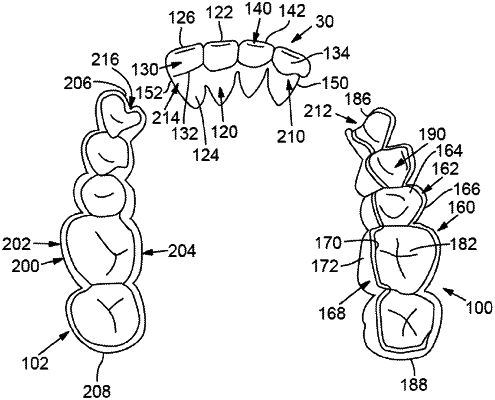| CPC A61C 7/36 (2013.01) [A61C 7/08 (2013.01); A61C 19/05 (2013.01); A61F 5/566 (2013.01); A61F 2005/563 (2013.01)] | 19 Claims |

|
1. A dental appliance for occupying the intra-occlusal space between opposed upper and lower pairs of teeth of a user of the dental appliance, the intra-occlusal space being the space or distance between the opposed upper and lower teeth measured when the user's mandible is in a relaxed position, minus a freeway space, the dental appliance comprising:
first and second dental appliance components, wherein the first dental appliance component is for a first side of the user's mouth and the second dental appliance component is for the second side of the user's mouth, wherein each of the first and second dental appliance components comprises
a lateral body that defines teeth receiving pockets that are adapted to receive and engage one of upper and lower posterior teeth of the user at a respective side of the user's mouth to retain the lateral body in place, the lateral body comprising a lateral body occlusal portion having a thickness selectively dimensioned to substantially equal to the intra-occlusal space between the upper and lower posterior teeth at the respective side of the user's mouth and a lateral body exterior occlusal surface that is shaped to contact and conform to opposing natural teeth;
first and second lateral body end portions, wherein a first of the teeth receiving pockets at the first lateral body end portion is shaped to resiliently engage a first posterior tooth at the respective side of the user's mouth and a second of the teeth receiving pockets at the second lateral body end portion is shaped to resiliently engage a second posterior tooth at the respective side of the user's mouth, thereby retaining the lateral body in place by snap-fit mechanical retention;
a lateral body apical portion extending apically from the lateral body occlusal portion, the lateral body apical portion extending apically at least past a height of a contour of a respective crown thereof for each of the engaged teeth, the apical portion having
a buccal wall with a buccal wall interior surface that is configured to resiliently engage buccal facial surfaces of the engaged teeth and an opposed buccal wall exterior surface shaped to mimic natural teeth anatomy, and
a lingual wall with a lingual wall interior surface that is configured to resiliently engage lingual surfaces of the engaged teeth and an opposed lingual wall exterior surface shaped to mimic natural teeth anatomy,
wherein the lingual wall has a lingual wall thickness of 0.3 mm to 0.6 mm to preserve tongue space within the user's dental arch, and
a third appliance component separately removable relative to the first and second appliance components, the third appliance component having a functional front body that defines teeth receiving pockets adapted to resiliently engage one or more of the upper or lower anterior teeth of the user to retain the third appliance component in place, the front body comprising a front body occlusal portion having a thickness that is substantially equal to the intra-occlusal space between the upper and lower anterior teeth of the user and a front body exterior occlusal surface shaped to contact and conform to opposing natural teeth;
wherein the first and second dental appliance components are functional when worn by the user, permitting movement and occlusal contacts between the lateral body exterior occlusal surface of the first dental appliance component and the opposing natural teeth on the first side of the user's mouth and between the lateral body exterior occlusal surface of the second dental appliance component and the opposing natural teeth on the second side of the user's mouth, to enable functional occlusion allowing speech, mastication and swallowing.
|